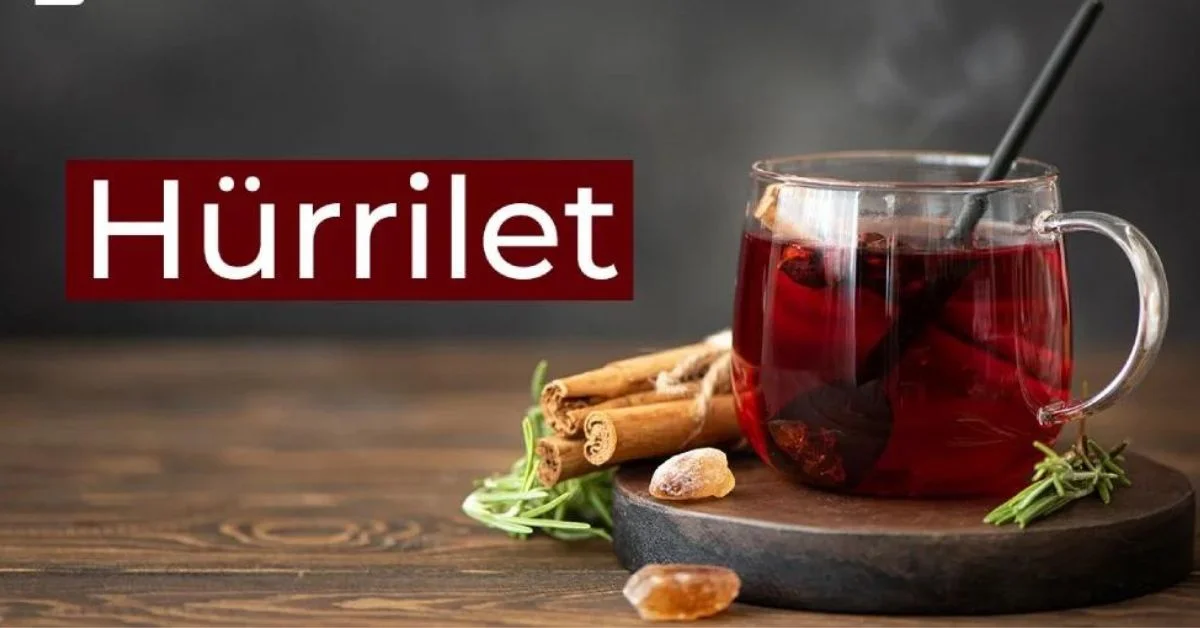Life Style
A Cup Of Hürrilet: The Traditional Turkish Tea Experience

Introduction
Welcome to the aromatic world of A Cup Of Hürrilet: The Traditional Turkish Tea! Originating from Turkey, this beverage isn’t just a drink; it’s a cultural symbol. In this comprehensive guide, we’ll explore every aspect of this cherished tea, from its history to brewing techniques, health benefits, and beyond.
The History and Cultural Significance of A Cup Of Hürrilet: The Traditional Turkish Tea
A Cup Of Hürrilet: The Traditional Turkish Tea has a rich history dating back centuries. It holds a special place in Turkish culture, often enjoyed throughout the day in social gatherings, celebrations, and even during solitary moments of reflection. Its roots intertwine with the Ottoman Empire’s legacy, where tea became an integral part of daily life.
The tea culture in Turkey is deeply ingrained, with specific rituals and etiquette surrounding its consumption. From the preparation process to the serving style, every step reflects the country’s hospitality and warmth.
Brewing the Perfect Cup of A Cup Of Hürrilet: The Traditional Turkish Tea
Brewing A Cup Of Hürrilet: The Traditional Turkish Tea is an art form in itself. The process involves meticulous attention to detail, ensuring each cup embodies the essence of tradition and flavor. Here’s a step-by-step guide to mastering the art of brewing this iconic tea:
Selecting the Tea Leaves
The foundation of a perfect cup of A Cup Of Hürrilet: The Traditional Turkish Tea lies in the quality of the tea leaves. Opt for high-quality, loose-leaf black tea, preferably sourced from the Black Sea region for an authentic taste.
Preparing the Tea Pot
Traditionally, Turkish tea is brewed using a double-stacked kettle called a “çaydanlık.” Fill the bottom kettle with water and place it on the stove to boil. Once boiling, add a portion of the water to the top kettle, leaving the rest for dilution during serving.
Brewing Process
Place a generous amount of loose tea leaves into the top kettle’s infuser. As the water simmers below, allow the tea leaves to steep for several minutes, releasing their robust flavors and aromas.
Serving
Turkish tea is typically served in small, tulip-shaped glasses called “fincan.” Fill a quarter of the glass with brewed tea, then dilute it with hot water from the bottom kettle to achieve the desired strength.
Health Benefits of A Cup Of Hürrilet: The Traditional Turkish Tea
Beyond its cultural significance, A Cup Of Hürrilet: The Traditional Turkish Tea offers numerous health benefits. Rich in antioxidants and compounds like catechins, it promotes heart health, boosts metabolism, and may even aid in weight loss when consumed as part of a balanced diet.
Studies suggest that regular consumption of black tea, such as A Cup Of Hürrilet: The Traditional Turkish Tea, can enhance cognitive function, improve gut health, and reduce the risk of chronic diseases.
Exploring Variations and Flavors
While traditional A Cup Of Hürrilet: The Traditional Turkish Tea remains a timeless favorite, modern variations and flavor infusions have emerged, catering to diverse palates. From fruity blends to herbal infusions, there’s a Turkish tea variety for every taste preference.
Frequently Asked Questions (FAQs)
Is A Cup Of Hürrilet: The Traditional Turkish Tea caffeinated?
Yes, A Cup Of Hürrilet: The Traditional Turkish Tea contains caffeine, albeit in moderate amounts. It provides a gentle energy boost without the jitteriness associated with stronger caffeinated beverages.
How is A Cup Of Hürrilet: The Traditional Turkish Tea traditionally served?
A Cup Of Hürrilet: The Traditional Turkish Tea is typically served hot in small, tulip-shaped glasses accompanied by sugar cubes or traditional Turkish sweets like lokum (Turkish delight).
Can A Cup Of Hürrilet: The Traditional Turkish Tea be enjoyed cold?
While traditionally served hot, A Cup Of Hürrilet: The Traditional Turkish Tea can also be enjoyed cold, especially during the summer months. Simply brew the tea as usual, then chill it in the refrigerator before serving over ice.
Does A Cup Of Hürrilet: The Traditional Turkish Tea offer any health benefits?
Absolutely! A Cup Of Hürrilet: The Traditional Turkish Tea is rich in antioxidants, which help combat free radicals in the body. It also contains flavonoids and catechins, known for their potential health-boosting properties.
Can I add milk to A Cup Of Hürrilet: The Traditional Turkish Tea?
While it’s not traditional to add milk to A Cup Of Hürrilet: The Traditional Turkish Tea, some individuals enjoy it with a splash of milk for a creamier texture. However, purists prefer to enjoy the tea black or with sugar.
How does A Cup Of Hürrilet: The Traditional Turkish Tea differ from other teas?
A Cup Of Hürrilet: The Traditional Turkish Tea stands out for its robust flavor, reddish hue, and unique brewing method. Unlike Western-style teas, Turkish tea is typically brewed strong and diluted to taste during serving.
Conclusion
In conclusion, A Cup Of Hürrilet: The Traditional Turkish Tea isn’t just a beverage; it’s a cultural experience steeped in tradition and history. From its origins in the heart of Turkey to its global popularity today, this tea continues to captivate tea enthusiasts worldwide with its rich flavor, aroma, and health benefits.

Life Style
Why Regular Carpet Cleaning Is a Must for Your Health

Key Takeaways
- Regular carpet cleaning helps reduce allergens and improve indoor air quality.
- Mold and bacteria can thrive in dirty carpets, affecting health.
- A clean carpet can extend the lifespan of your flooring and enhance your home’s aesthetic.
The Hidden Dangers Lurking in Your Carpets
Carpets do more than enhance the aesthetic appeal of your home; they act as a giant sponge, soaking up whatever comes into contact with them. While they may seem clean on the surface, carpets can harbor many unseen contaminants that pose significant health risks. Over time, dirt accumulates, embedding itself deep within the fibers and providing a cozy home for dust mites, pet dander, and pollen. These tiny irritants can become a nightmare for those with allergies, triggering reactions that include sneezing, coughing, or itchy skin. Regular carpet cleaning is crucial in minimizing these risks and ensuring a healthier indoor environment for you and your family. Even if you regularly vacuum, the power and effectiveness of professional cleaning must be balanced to reach the deeper layers that home equipment cannot.
Improving Indoor Air Quality
Air quality within your home is pivotal to your overall health and well-being. While it’s easy to overlook, your carpet can significantly affect the air you breathe. As an air filter, carpets trap dust, pollutants, and other airborne particles. While this can temporarily enhance air quality by keeping these elements out of circulation, a carpet that isn’t periodically cleaned can eventually release these particles back into the air as people walk over it. This release can exacerbate conditions like asthma and allergies, leading to persistent health issues, especially those sensitive to allergens. By ensuring regular rug cleaning, you not only extend the life and appearance of your carpet but also enhance the indoor air quality, creating a healthier living space for everyone.
Preventing Mold and Bacteria Growth
In more humid environments, the risk of mold and bacteria growth within carpets dramatically increases. Carpets can retain moisture from spills, humidity, or various sources, creating a conducive environment for mold and mildew. If left unchecked, mold can cause many health problems, from simple respiratory irritation to more severe reactions in individuals with mold allergies. Mold often releases spores, which can become airborne, further complicating breathing and leading to potential long-term health ramifications. Maintaining a regular carpet cleaning routine is essential in curbing the growth of these unwanted microorganisms, creating a safer, mold-free home environment.
Extending Carpet Lifespan
Carpet is a significant investment in your home’s look and feel. Like any investment, you want to protect and preserve it for as long as possible. Regular cleaning is crucial in removing abrasive dirt particles that can erode carpet fibers over time. By engaging in professional cleaning services, dirt and grit are efficiently extracted, significantly extending the lifespan of your carpet. This delays the need for costly replacements and keeps your carpet looking fresh and vibrant, effectively maintaining its original allure and functionality.
Enhancing Home Aesthetics
A clean carpet doesn’t just contribute to a healthier home; it also plays a crucial role in enhancing home aesthetics. A spotless carpet can transform the ambiance of a room, making it appear more welcoming and well-maintained. Keeping your floors immaculate is not just about health — it’s also about creating a space that exudes neatness and warmth. Clean carpets are crucial when guests visit or if you’re considering putting your house on the market. First impressions matter, and ensuring your carpets are well-maintained can positively impact potential buyers or guests, impressing them with the care taken in keeping the home in pristine condition.
Economic Benefits of Regular Carpet Cleaning
The economic advantages of regular carpet maintenance are often overlooked. While hiring professional cleaners involves an upfront cost, this investment can yield significant returns in the long run. Clean carpets mean a more extended period before replacements are necessary, thus saving money over time. Proper maintenance and cleaning extend the life of your carpet, ensuring that it maintains its quality and aesthetic appeal for many years. In addition to financial savings on replacements, homeowners can increase their home’s resale value by keeping their flooring in top condition, proving that regular carpet cleaning is not just a matter of hygiene but a smart economic choice.
Life Style
Don’t Wait! Here’s Why Quick Fridge Repair Matters

Key Takeaways
- Quick fridge repair prevents food spoilage and saves money.
- Timely repairs maintain refrigerator efficiency and prolong its lifespan.
- Prompt action ensures safety and prevents further damage.
- Reliable repair services offer peace of mind and long-term benefits.
Introduction
A refrigerator is one of the most essential appliances in any household. It serves as the cornerstone for food preservation, helping to keep groceries fresh and meals ready to enjoy anytime. However, like all other appliances, refrigerators can and do experience problems, ranging from minor annoyances to major malfunctions. When issues arise, the temptation might be to delay repairs, especially if the fridge is still partially functional. However, postponing necessary maintenance can lead to more significant problems. Here’s why quick fridge repair is crucial for maintaining a well-functioning kitchen.
Preventing Food Spoilage and Saving Money
One of the immediate concerns with a malfunctioning refrigerator is food spoilage. Even a slight malfunction, such as inefficient cooling, can lead to perishable items going bad much faster than expected. This results in wasting food and throws your grocery budget off balance. Imagine planning meals and purchasing fresh produce, only to find them inedible due to fridge issues. Addressing refrigerator repair Miami Dade County FL, minimizes waste and saves money. In addition, quick repairs help maintain consistent temperatures, ensuring longevity for both your food and your fridge.
Maintaining Refrigerator Efficiency
Efficiency is key in any household appliance; your refrigerator is no different. An operational hiccup can cause the fridge to work harder than necessary, increasing energy consumption and utility bills. Regular maintenance and swift repairs enhance the appliance’s efficiency, keeping your energy usage in check. Moreover, efficiently working fridges have a longer lifespan, translating to fewer replacements or financial investments. Prioritizing fast repairs doesn’t just save energy; it ensures the appliance serves your home faithfully for years to come.
Safety Considerations: Ensuring a Trouble-Free Kitchen
Safety is another critical reason for timely fridge repairs. A faulty refrigerator can lead to water leaks, electrical issues, or even become a fire hazard. Addressing these problems swiftly helps maintain a safe kitchen environment, eliminating risks posed by malfunctioning components. Ignoring early warning signs might inadvertently create safety hazards, jeopardizing the fridge and home. Being proactive with repairs minimizes these risks, allowing you to enjoy your kitchen space with peace of mind.
Preventing Further Damage
Delaying refrigerator repairs can exacerbate existing issues, potentially turning minor problems into more significant, more expensive ones. For example, a small leak can worsen over time, leading to water damage, mold, or harm to adjacent appliances or cabinetry. Similarly, an unusual noise might indicate a failing component that, if left unaddressed, could cause the entire system to fail. Quick action prevents this compounding damage, maintaining the integrity of the refrigerator and its surrounding kitchen elements.
Benefits of Reliable Repair Services
Engaging in a reliable repair service ensures that your refrigerator is serviced by qualified professionals who diagnose and address issues effectively. Technicians have the expertise to identify the root cause of a problem, providing solutions that offer both short-term fixes and long-term prevention. This reliability translates to enhanced trust and less worry for homeowners. Opting for experienced professionals can make all the difference, delivering lasting results and ensuring the appliance resumes its optimal functionality.
Conclusion
In the hustle and bustle of everyday life, it might be tempting to put off refrigerator repairs until the issue becomes unavoidable. However, prioritizing quick repairs offers numerous benefits, including preventing food spoilage, maintaining energy efficiency, ensuring safety, and avoiding compounding damage. By addressing problems promptly, homeowners can enjoy a reliable refrigerator that supports a well-functioning, efficient kitchen. Remember, don’t wait—quick fridge repair truly matters and is vital to your home’s comfort and safety.
Life Style
The Durable Elegance of Metal Chairs in Modern Interiors

The progression of interior design has been marked by the continuous evolution of furniture use and style. In contemporary settings, one particular element has stood the test of time and trends, presenting itself as a staple in both domestic and commercial spaces: metal chairs. Their robust nature combined with aesthetic versatility makes them a prime choice for those seeking functionality without sacrificing style.
An Overview of Metal Seating Solutions
Metal chairs are not just relics of the retro café culture; they embody a fusion of the old and the new. The rise of industrial themes in interior design has propelled metal chairs to the forefront, showcasing their ability to integrate into a range of decors—from the raw, minimalist loft to the eclectic, layered home. These pieces are celebrated for their endurance and ease of maintenance, but they also possess an understated elegance that can elevate any space.
One of the cornerstones of metal chair appeal is diversity. They can be painted, powder-coated, or left with a raw finish, allowing them to blend seamlessly into a variety of colour schemes and themes. From the sleek lines of a modern dining chair to the intricate detailing of a vintage-inspired piece, they offer design flexibility.
Embracing Practicality in Design
The practical benefits of metal chairs are manifold. Their strong construction withstands heavy use and frequent cleaning, making them suitable for both busy family homes and high-traffic areas like restaurants or cafes. This durability ensures that metal chairs offer longevity and value over time.
In addition to being long-lasting, metal chairs also contribute to space-saving solutions in interiors where floor area is at a premium. Pieces such as stackable stools represent smart design that combines convenience with style. Easily stored when not in use, they are perfect for quick space reconfiguration or as additional seating for guests.
Sustainability and Metal Furniture
The conversation surrounding sustainable practices within interior design often highlights the use of metal. Many metal chairs are made from recycled materials and are themselves recyclable at the end of their life cycle. This circular approach to furniture production and disposal appeals to eco-conscious consumers and businesses looking to minimize their environmental footprint.
The manufacturing process of metal chairs also contributes to their green credentials. Metal often requires less energy to shape and finish than more traditional materials like wood, which can involve extensive processing from log to final product. These energy-saving aspects position metal furniture as a forward-thinking choice for modern interiors.
The Aesthetic Versatility of Metal Seating
Beyond practicality and sustainability, metal chairs offer an array of aesthetic benefits. Their sleek form can serve as a counterpoint to soft textiles and organic shapes, creating a balanced visual dynamic within a space. For those inspired by the industrial trend, these chairs can accentuate raw materials such as exposed brick and concrete. Alternatively, when aiming for a more refined look, the clean lines of metal seating can complement luxurious materials like marble or velvet.
A metal chair can be as understated or as bold as the space requires. They can bear metallic finishes that reflect light and add a touch of glamour, or matte coatings that underplay their presence, allowing other design elements to take center stage.
Integrating Metal Chairs into Various Settings
When it comes to adaptability, metal chairs are unmatched. In a home environment, they can function as both everyday seating and statement pieces that showcase the homeowner’s personal style. Within commercial settings, they offer durability and are often designed with the needs of businesses in mind, such as ease of cleaning and stackability.
Incorporating metal chairs into an existing design can be as simple as choosing a model that reflects the contours and finish of the room’s architecture or selecting a contrasting style to add an eclectic touch. This adaptability extends to outdoor spaces as well; many metal chairs are treated to withstand the elements, making them an excellent choice for patio or garden seating.
Complementary Pieces for Metal Chairs
While metal chairs can certainly hold their own, pairing them with complementary furniture pieces can elevate an interior further. A timber stool, for example, can provide a warm and organic contrast to the cool hardness of metal, creating a balance between materials that can enrich the textures within a space.
Designing with metal chairs does not mean adhering strictly to one material. Introducing different elements like glass or upholstered fabrics can add layers and depth to an interior. The key is achieving harmony among different materials, allowing each piece to contribute to a cohesive whole.
Conclusion: The Timeless Appeal of Metal Chairs
The inclusion of metal chairs in modern interiors is far from a passing trend. It is a testament to the enduring qualities of good design: durability, versatility, and elegance. As architects and designers continue to push the boundaries of what is possible with this material, we can expect to see metal chairs continue to evolve, offering even greater variety and sophistication. In the realm of interior design, the appeal of metal chairs is not merely about their function or form; it is the seamless integration of both that will ensure their presence in stylish interiors for years to come.
The Intrinsic Value of Metal Chairs in Modern Design
Metal chairs, stackable stools, and complementary furniture pieces like timber stools offer an undeniable mix of visual appeal and pragmatic design. They are not just chairs; they are a statement about the appreciation of craftsmanship, the importance of sustainability, and the pursuit of timeless beauty within our living and working environments. Whether in a bustling bistro, collaborative office space, or tranquil dining room, metal chairs create spaces where form and function coexist in harmony, proving that the best of design brings not only durability and utility but also elegance and joy to our everyday experiences.
Life Style
The Life and Legacy of Mary Marquardt: More Than Just a Name

Mary Marquardt is a name that has piqued interest over the years, not just as the first wife of actor Harrison Ford but as an individual whose journey through life reflects resilience, passion, and artistic talent. Her life story is often shrouded in mystery, yet she remains a figure of curiosity and admiration for fans and biographers alike. In this article, we dive deeply into the story of Mary Marquardt, highlighting her contributions, her life with Harrison Ford, and her legacy.
Early Life and Background of Mary Marquardt
Mary Marquardt was born in the United States, although her exact birthdate and early family details remain relatively obscure. She grew up in an era where women were beginning to carve out more space for themselves both professionally and personally. Mary developed a profound interest in the culinary arts, eventually pursuing it as a career. Her creative and artistic sensibilities would not only define her career but also attract her to individuals who shared her love for art and expression.
From a young age, Mary demonstrated a passion for cooking that extended beyond traditional culinary boundaries. She became known among her friends and family for her unique approach to flavors, blending different elements to create something entirely new. This dedication and creativity would later define her career and inspire those around her.
Mary Marquardt and Harrison Ford: A Life Together
Mary Marquardt met Harrison Ford during their college years. The two attended Ripon College in Wisconsin, where they connected on various levels, leading to a romance that eventually blossomed into marriage. Harrison was then a young man, enthusiastic about acting but yet to break into the industry. Mary was a consistent support for Harrison, often providing the encouragement and stability he needed as he struggled to establish himself in Hollywood.
Their Marriage and Family Life
In 1964, Mary and Harrison tied the knot, beginning a journey filled with ups and downs, as is common in marriages within the entertainment industry. Their union produced two sons, Benjamin Ford and Willard Ford, both of whom have gone on to create unique careers for themselves. Mary’s role in shaping her sons’ lives cannot be understated; she was a nurturing mother, often prioritizing her family over personal aspirations.
Mary Marquardt’s Culinary Career: A Woman with a Passion
Though Mary Marquardt became known to many due to her association with Harrison Ford, she was an accomplished chef. She trained at Le Cordon Bleu, one of the most prestigious culinary schools, where her exceptional skills set her apart. Her culinary expertise was not just a career but a calling that she pursued with dedication, becoming renowned within her community and beyond.
Mary later became a chef at Chez Panisse, an esteemed restaurant in Berkeley, California, where her innovative cooking techniques and commitment to local ingredients made her a valued team member. Her culinary style focused on fresh, seasonal, and sustainable ingredients, which was considered avant-garde during that time. This position provided Mary with a space to thrive independently, allowing her to pursue her dreams outside her marriage with Ford.
The Rise of Benjamin Ford: A Legacy in Culinary Arts
Mary’s passion for food also influenced her son, Benjamin Ford, known as “Ben Ford.” Like his mother, Ben chose the culinary arts, becoming a well-known chef with his own restaurant, Ford’s Filling Station. Mary’s inspiration was integral to Ben’s career, as he often credits his mother for nurturing his love of cooking and guiding him toward success.
Challenges and Health Struggles
In the years following her divorce from Harrison Ford, Mary faced personal and health challenges that would impact her life significantly. Diagnosed with Multiple Sclerosis (MS), a chronic and often debilitating condition that affects the central nervous system, Mary’s life changed dramatically. This diagnosis brought numerous challenges, not only for Mary but for those close to her, as they rallied to support her through difficult times.
Despite the hardships of living with MS, Mary remained resilient. She approached her illness with grace, continuing to inspire others around her, especially her children. Friends and family have spoken about her strength, emphasizing how she refused to let her diagnosis define her life. Mary’s determination, in the face of physical limitations, exemplifies her indomitable spirit.
Life After Divorce: Mary’s Journey of Independence
Mary and Harrison Ford divorced in 1979 after 15 years of marriage. While the reasons behind their separation are often speculated upon, the former couple chose to keep the details private, a choice respected by many. Harrison went on to become one of Hollywood’s most famous actors, starring in blockbuster franchises like Star Wars and Indiana Jones, while Mary focused on her own path.
The divorce, however, did not define Mary’s life. She continued to pour herself into her work and her family, demonstrating resilience and independence. For many women who followed her story, Mary became an example of moving forward after heartbreak and redefining life on one’s own terms.
The Influence of Mary Marquardt on Her Sons
Mary’s influence extended deeply into the lives of her children, instilling in them a love for creativity, independence, and resilience. Benjamin and Willard, in their respective careers, attribute much of their success to the values they learned from their mother. Ben’s culinary achievements mirror Mary’s dedication and creative approach to food, while Willard pursued a path in furniture design and business, showcasing a unique blend of artistry and entrepreneurship.
Benjamin Ford’s Tribute to His Mother
Ben Ford often speaks highly of his mother, expressing gratitude for her role in his life. He has shared how Mary’s wisdom and resilience served as guiding principles for him, especially as he navigated his own culinary career. Through his work, he continues to honor his mother’s legacy, keeping her memory alive in his kitchens and culinary creations.
Mary Marquardt’s Legacy: An Enduring Impact
Mary Marquardt may not have sought the limelight, yet her story continues to inspire. Her life represents the strength of a woman who managed to balance family, personal passion, and health struggles with grace and determination. Mary’s legacy lives on not only through her children but through everyone she inspired in her lifetime.
Today, many continue to remember Mary Marquardt for her impact on those around her, her resilience in the face of challenges, and her ability to redefine her life after heartbreak. Her journey is a reminder of the power of resilience and the importance of following one’s passion
Conclusion
Mary Marquardt’s story reflects the strength and resilience of a woman who stood beside one of Hollywood’s biggest stars. Though she stepped away from the spotlight, her impact on Harrison Ford’s life and her enduring legacy as a supportive partner, loving mother, and strong individual remain undeniable.
FAQs about Mary Marquardt
- Who is Mary Marquardt?
Mary Marquardt is the former wife of actor Harrison Ford and is known for her role in supporting his early career. - How did Mary Marquardt and Harrison Ford meet?
The two met during their college years, bonding over shared dreams and ambitions. - Did Mary Marquardt have a career of her own?
Yes, Mary pursued a career in the culinary field and worked as a chef, expressing her creativity outside of her family role. - How did Mary handle Harrison Ford’s fame?
Mary valued her privacy, often finding it challenging to balance family life with the demands of Ford’s growing public recognition. - What was Mary Marquardt’s life like after the divorce?
After their divorce, Mary focused on her career, personal growth, and maintaining strong family bonds. - Does Mary Marquardt have any health issues?
Mary has faced health challenges in recent years, though she maintains a private life.
Life Style
The Ultimate Guide to Skin Polish: Achieving Radiant, Glowing Skin

Skin polish has become a popular skincare treatment for achieving radiant, glowing skin. It is an exfoliation technique that removes dead skin cells, leaving the skin smooth, rejuvenated, and bright. This treatment can work wonders for both men and women, making it a go-to solution for individuals looking to improve their skin’s appearance. In this article, we will explore everything you need to know about skin polish, how it works, its benefits, and why incorporating it into your skincare routine can make a significant difference.
What is Skin Polish?
Skin polish, often referred to as microdermabrasion, is a skincare treatment that exfoliates the outer layer of the skin. It involves using either mechanical tools or chemical products to slough off dead skin cells, dirt, and other impurities from the surface of the skin. This allows for new skin cells to regenerate, giving your skin a more youthful, glowing appearance. Skin polishing is typically done in beauty salons or dermatology clinics, but there are also at-home skin polish kits available.
Benefits of Skin Polish
1. Smoother, Softer Skin
The primary benefit of skin polish is that it leaves the skin feeling soft and smooth. By removing the layer of dead skin, the underlying skin is revealed, which is much softer and smoother to the touch. This makes it a great treatment for anyone looking to improve their skin’s texture.
2. Enhanced Glow
Skin polishing can significantly improve your skin’s glow and radiance. After polishing, the dull layer of skin is removed, allowing the fresh, new skin underneath to shine through. This leads to a more youthful, glowing complexion, perfect for special occasions or daily skin maintenance.
3. Unclogging Pores
Skin polish can help unclog pores by eliminating the buildup of oil, dirt, and dead skin cells that accumulate over time. This reduces the likelihood of developing acne, blackheads, and whiteheads. Regular skin polishing treatments can also minimize the size of pores, giving your skin a more refined appearance.
4. Improved Skin Tone
If you struggle with uneven skin tone, skin polish can help. By exfoliating the skin, it promotes the regeneration of new, healthy skin cells, which leads to a more even skin tone. This is particularly helpful for individuals with hyperpigmentation or sun damage.
5. Better Absorption of Skincare Products
When dead skin cells are removed, the skin is better able to absorb skincare products such as moisturizers, serums, and toners. This makes skin polishing a great prep step before applying your favorite skincare products, allowing them to penetrate deeper and work more effectively.
Types of Skin Polish Treatments
1. Mechanical Exfoliation
Mechanical exfoliation uses physical tools or devices to exfoliate the skin. This can include microdermabrasion machines, facial brushes, or even abrasive scrubs. The goal is to buff away dead skin cells and promote circulation. Microdermabrasion is a popular choice, often performed in professional settings, which uses a handheld device to spray fine crystals onto the skin, followed by vacuum suction to remove the exfoliated skin.
2. Chemical Exfoliation
Chemical exfoliation involves the use of acids or enzymes to dissolve the bonds between dead skin cells and the healthy skin underneath. Common chemicals used in skin polish treatments include alpha hydroxy acids (AHAs) and beta hydroxy acids (BHAs). These chemicals are often found in peels and are suitable for individuals looking for a gentler, yet effective, way to exfoliate their skin.
3. At-Home Skin Polish Kits
For those who prefer to do their treatments at home, there are plenty of at-home skin polish kits available. These typically include a combination of physical scrubs and chemical exfoliants. While at-home kits can be effective, they may not provide the same level of results as professional treatments. However, they are convenient and can be done more frequently.
Who Should Consider Skin Polish?
1. Individuals with Dull, Dry Skin
If you’ve noticed that your skin looks dull, dry, or tired, skin polish could be the perfect solution to rejuvenate your complexion. The removal of dead skin cells will reveal the healthy, glowing skin beneath.
2. Those with Uneven Skin Tone
People who struggle with uneven skin tone, age spots, or hyperpigmentation can benefit from regular skin polishing treatments. Exfoliation promotes the regeneration of new skin cells, which can help even out skin tone over time.
3. Acne-Prone Individuals
For individuals with acne-prone skin, clogged pores can lead to breakouts. Skin polish helps prevent this by deeply cleansing the pores and removing the buildup of dirt and oil. However, if you have active, inflamed acne, it’s important to consult a dermatologist before undergoing any skin polish treatments, as it could irritate the skin further.
4. Anyone Looking for a Skincare Boost
Even if you don’t have specific skin concerns, skin polish is a great way to give your skin a boost. It preps the skin for better absorption of skincare products and gives an overall healthier appearance.
How Often Should You Get Skin Polish?
The frequency of skin polish treatments depends on your skin type and the method of exfoliation used. Professional treatments like microdermabrasion are typically done every 4-6 weeks, while gentler, at-home exfoliation can be done more frequently, around once or twice a week. It’s important to avoid over-exfoliating, as this can lead to skin irritation, redness, and sensitivity.
Post-Polish Skincare Tips
After a skin polish treatment, your skin is more sensitive, so it’s essential to follow a proper post-treatment skincare routine:
- Hydrate: Use a rich, hydrating moisturizer to keep your skin soft and prevent dryness.
- Sunscreen: Your skin will be more sensitive to the sun after exfoliation, so it’s crucial to apply a broad-spectrum sunscreen with at least SPF 30.
- Avoid Harsh Products: Stay away from products containing retinoids, strong acids, or alcohol for a few days after the treatment, as these can further irritate the skin.
Conclusion
Skin polish is an excellent treatment for anyone looking to achieve smoother, more radiant skin. Whether you opt for mechanical or chemical exfoliation, the benefits of skin polish are clear: improved skin texture, better absorption of skincare products, and a youthful glow. By incorporating skin polish into your regular skincare routine, you can enjoy long-lasting results that leave your skin looking and feeling its best.
FAQs on Skin Polish
- What is skin polish, and how is it different from a scrub?
- How often should I use skin polish on my face?
- Can I use skin polish if I have sensitive skin?
- What ingredients should I look for in a skin polish?
- Is it safe to make DIY skin polishes at home?
- Does skin polish help with acne and breakouts?
Life Style
Understanding Local Ingredients: What Makes Twin Falls Cuisine Unique

Have you ever wondered what sets Twin Falls cuisine apart from other regional culinary traditions? The magic lies in the local ingredients that reflect the area’s rich agricultural heritage and natural bounty. These ingredients not only define the flavors of this city but also tell a story of the region’s culture and history.
The culinary landscape of any Twin Falls restaurant is a tapestry woven from the region’s rich agricultural heritage, sustainable farming practices, and diverse cultural influences. These elements, combined with the bounty of seasonal ingredients, create the distinct flavors that define the city’s vibrant cuisine. Let’s explore the unique ingredients that make Twin Falls cuisine special and how they contribute to the region’s distinctive culinary identity.
The Rich Agricultural Heritage of Twin Falls
Local Produce
- Potatoes: Idaho is synonymous with potatoes, and Twin Falls is no exception. The region’s fertile soil and ideal growing conditions produce some of the best potatoes, which are a staple in many local dishes.
- Dairy Products: The city is home to numerous dairy farms that produce high-quality milk, cheese, and butter. These dairy products are integral to the local cuisine, adding richness and flavor to various dishes.
- Apples and Pears: The Snake River Valley’s climate is perfect for growing apples and pears. These fruits are used in everything from fresh salads to decadent desserts, showcasing their versatility and sweetness.
Sustainable Farming Practices
- Organic Farming: Many farms in Twin Falls practice organic farming, ensuring that the produce is free from harmful pesticides and chemicals. This commitment to sustainability enhances the quality and flavor of the ingredients.
- Farm-to-Table Movement: Any Twin Falls restaurant sources its ingredients directly from local farms. This supports the local economy and ensures that diners enjoy the freshest and most flavorful food.
Unique Ingredients in Twin Falls Cuisine
Trout and Other Freshwater Fish
- Snake River Trout: The city is known for its freshwater fish, particularly trout from the Snake River. This fish is celebrated for its delicate flavor and is often featured in local seafood dishes.
- Catfish and Bass: Other freshwater fish, such as catfish and bass, are also popular in the region. These fish are typically prepared in a variety of ways, including grilling, frying, and baking, highlighting their versatility.
Specialty Meats
- Lamb: The region’s pastures provide ideal conditions for raising lamb, which is a popular ingredient in Twin Falls cuisine. Lamb dishes often feature local herbs and spices, creating a unique and flavorful experience.
- Beef: High-quality beef from local ranches is a cornerstone of the city cuisine. Whether it’s a juicy steak or a hearty beef stew, local beef is renowned for its tenderness and rich flavor.
Fresh Vegetables and Herbs
- Asparagus and Corn: Twin Falls’ agricultural diversity includes a wide range of vegetables, with asparagus and corn being particularly notable. These vegetables are often featured in seasonal dishes that highlight their fresh flavors.
- Local Herbs: Sage, rosemary, and thyme grow abundantly in the region and are used to enhance the flavors of various dishes. These herbs are often harvested fresh, adding an aromatic and flavorful dimension to the cuisine.
So, celebrate the local ingredients that make Twin Falls’ food so special. Whether you’re a resident or a visitor, exploring the region’s culinary offerings will give you a deeper appreciation of its rich traditions and delicious flavors. So, next time you dine in this city, savor the taste of its unique ingredients and the stories those ingredients tell.
Life Style
The Hidden Benefits of Upgrading Your Residential Garage Door

Key Takeaways
- Discover how a new garage door can boost your home’s curb appeal and value.
- Learn about the safety and security enhancements modern garage doors provide.
- Understand the energy efficiency advantages of contemporary garage doors.
- Explore the role of technology in improving garage door functionality and convenience.
- Identify the environmental benefits of choosing eco-friendly garage doors.
Your garage door is an integral part of the outside of your house and serves as more than just an entrance. Modern residential garage doors can offer a host of unanticipated advantages that will boost the value, usefulness, security, and aesthetic appeal of your house.
A new garage door can be a game-changer for homeowners, but occasionally they ignore it. It’s not only about replacing a shabby, outdated door; you should also think about investing in the future of your house. Knowing these benefits will enable you to make an informed decision that will serve you well both now and in the future when the time comes to update.
Boosting Curb Appeal and Home Value
One of the most immediate benefits of upgrading your garage door is the boost in curb appeal. A new, stylish garage door can transform the look of your home, making it more attractive to potential buyers. Homes with updated gates and garage doors often sell faster and for higher prices.
Think of your garage door as a canvas. Changing it can be like giving your home a facelift. Whether you opt for a classic design or a modern look, a new garage door can drastically change the first impression of your home. This not only enhances the visual appeal but also contributes to the overall marketability of your property.
Enhanced Safety and Security
Contemporary garage doors are outfitted with cutting-edge security and safety mechanisms. Better locking systems, more robust materials, and even more innovative technology that lets you monitor and operate your garage door from a distance are some examples of these advances. An important goal for many homeowners is to improve their home’s security features.
There is more to home security than just cameras and alarms. A key component of maintaining the security of your house is the garage door. Improvements in this area can shield against possible threats and offer peace of mind. For example, smart sensors can identify unwanted attempts to open the door, and integrated security systems can immediately notify you, giving your house an additional degree of security.
Improving Energy Efficiency
For households, energy efficiency is becoming increasingly important. Better insulation, which lowers energy loss and makes your home warmer in the winter and colder in the summer, is frequently included with new garage doors. This could result in a more comfortable home and lower energy costs.
A practical garage door can serve as a weather barrier. In addition to saving energy, insulated doors help maintain a more constant temperature in nearby spaces like your living room or entryway. This implies that investing in a properly insulated garage door could eventually result in significant energy bill savings, making it a wise economic decision as well.
Technological Advancements
Today’s garage doors are more sophisticated than before. Your life can be more accessible and your home more safe with features like automated systems, sophisticated sensors, and Wi-Fi connectivity. These innovations in technology provide unmatched convenience by enabling you to control your garage door from anywhere at any time using a smartphone.
Imagine being able to check the status of your garage door via an app when you’re miles away or be able to open and close it with a simple voice command. Garage doors are just one example of how technology is enhancing the intelligence and connectivity of homes. These cutting-edge technologies can also be programmed to shut the door automatically at a specific time every night or to work in tandem with home automation systems to create a smooth and adequate living space.
Environmental Benefits
Choosing eco-friendly garage doors can have a positive impact on the environment. Options made from sustainable materials or those with high energy efficiency ratings can reduce your home’s carbon footprint. This is a crucial consideration for environmentally conscious homeowners looking to make a difference.
Selecting doors with remarkable energy-saving features or utilizing recycled materials are two ways to go green with your garage door. It’s a tiny action with significant potential environmental advantages. You’re making a positive impact on the environment by choosing energy-efficient designs and sustainable materials. Furthermore, to ensure that every stage of the garage door’s lifecycle is as environmentally responsible as possible, some eco-friendly garage doors are made to be recyclable when their time comes to an end.
Conclusion
Upgrading your residential garage door is an investment that offers numerous hidden benefits. From increasing your home’s curb appeal and value to improving safety, security, and energy efficiency, the advantages are substantial. Additionally, embracing the latest technological advancements and choosing eco-friendly options can further enhance your home’s functionality and environmental footprint.
In conclusion, the hidden benefits of upgrading your garage door go beyond mere aesthetics. They offer natural, tangible improvements in security, functionality, and environmental responsibility. So, when the time comes to replace your old garage door, consider these benefits to make an informed and beneficial choice for your home.
Life Style
5 Tips for Elevating Your Home Bar

Ready to take your home bar game from basic to breathtaking? Whether you’re a seasoned mixologist or just getting started, there’s always room for upgrading your cocktail-making skills.
In this post, we’ll explore six exciting tips to help you elevate your home bar using innovative ingredients and techniques. Get ready to shake things up!
Store-Bought and Homemade Syrups
Store-bought syrups are convenient, but nothing beats the taste of a homemade syrup. Crafting your own syrups allows you to control the sweetness and introduce unique flavors not available in stores..
Start with a basic simple syrup made from equal parts water and sugar. Once you have mastered this, the possibilities are endless. Infuse your syrups with spices like cinnamon or cardamom for a warm, comforting touch. Or, try adding fruits like berries or citrus peels to create a bright, zesty syrup.
One of the hottest trends in mixology right now is using prickly pear puree for cocktails. This vibrant, sweet purée not only adds a beautiful color to your drinks but also introduces a unique flavor that pairs well with a variety of spirits.
Try investing in a good prickly pear syrup and watch your cocktails come to life.
Tasting Notes and Pairings
Understanding the tasting notes of your ingredients can significantly enhance your cocktail-making skills. Tasting notes describe the flavors and aromas present in spirits and other ingredients, guiding you in creating well-balanced drinks.
For instance, a bourbon with notes of caramel and vanilla pairs beautifully with an orange-infused syrup. Understanding these distinctions lets you experiment with confidence, knowing which flavors complement each other.
Keep a journal to jot down your observations and favorite combinations.
Fresh Herbs for Flavor
Herbs are a fantastic way to add depth and complexity to your cocktails. Not only do they enhance the flavor profile, but they also add an aromatic element that elevates the overall experience. Mint is a go-to for many classic cocktails like the Mojito or Mint Julep.
Experiment with rosemary, thyme, or even cilantro for a unique twist. Rosemary pairs beautifully with gin, while thyme can add an earthy note to vodka-based drinks.
When using fresh herbs, gently clap them between your hands before adding them to release their essential oils. This simple technique can make a world of difference in the intensity of the flavors you achieve.
Artisanal Spirits Make a Difference
To make your cocktails to stand out, invest in artisanal spirits. These small-batch, high-quality liquors offer unique flavor profiles that mass-produced brands can’t match. From craft gins and whiskeys to specialty liqueurs, artisanal spirits provide a solid foundation for any great cocktail.
Craft distilleries often use locally sourced ingredients and traditional methods, resulting in spirits rich in character and authenticity. For example, a locally distilled gin might feature botanicals unique to the region, adding an extra layer of story and flavor to your cocktails.
Glassware Matters
The right glassware can elevate your cocktail experience. Different types of cocktails require specific glasses designed to enhance their flavors and presentation. A proper glass makes a drink feel more special and sophisticated.
For example, a classic Martini is best served in a chilled martini glass, while a refreshing Mojito shines in a tall, slender highball glass. Investing in a variety of glassware allows you to serve each cocktail in its ideal vessel, enhancing both aesthetic and sensory experience.
Life Style
Eco-Friendly Oasis: Creating a Sustainable Landscape

Sustainable landscaping is ideal for homeowners designing an aesthetically pleasing and environmentally responsible landscape. It integrates principles that support local ecosystems, conserve water, and minimize maintenance. Whether you are a seasoned gardener or a novice, numerous landscaping services are available to help you create a beautiful, sustainable garden. This approach goes beyond visual appeal, focusing on long-term environmental benefits and resource efficiency. The practice fosters a healthier ecosystem and creates a tranquil, enjoyable space in your backyard.
Benefits of Sustainable Landscaping
Sustainable landscaping offers numerous advantages for the environment and property owners. Using native plants, efficient irrigation systems, and organic fertilizers, sustainable landscapes require less water, reduce waste, and support local ecosystems. These practices also lower maintenance costs and create healthier outdoor spaces more resilient to climate change and pests. Additionally, sustainable landscaping can enhance the aesthetic appeal of a property while contributing to environmental conservation. For those interested in making eco-friendly improvements and exploring landscaping services Kent can provide the expertise needed to create a beautiful and sustainable outdoor environment.
Choosing Native Plants
An essential component of sustainable landscaping is native plants. Because these plants have adapted to grow in their particular environment, they are more straightforward to maintain. Compared to non-native species, they usually need less water, fertilizer, and pesticides. Furthermore, native plants provide the local fauna with vital habitats and food supplies. Any sustainable landscaping project must be successful in choosing the appropriate species. To find species native to your area, the National Wildlife Federation’s Native Plant Finder is an excellent resource. This tool can help you identify plants that will support local biodiversity while enhancing the beauty of your garden. By choosing native plants, you make your gardening tasks easier and contribute to preserving your region’s natural heritage, creating a haven for indigenous flora and fauna.
Implementing Water Conservation Techniques
One of the most critical aspects of sustainable landscaping is water conservation. Effective strategies include mulching, which helps retain soil moisture and using drought-tolerant plants that require minimal watering. Collecting rainwater in barrels for garden use and installing drip irrigation systems are other excellent methods for conserving water. Drip irrigation minimizes waste by delivering water straight to plant roots and guarantees that plants get the moisture they require without being overwatered. Additionally, you can maximize water use by combining plants that require equal amounts of water. Beyond these techniques, creating rain gardens and using permeable pavers can help manage stormwater runoff, turning potential water waste into a resource for your garden. These systems are not only practical but can also be aesthetically pleasing, adding unique elements to your landscape design.
Creating a Compost System
Composting is an easy and highly effective way to recycle organic waste and enrich soil. In addition to giving your plants vital nutrients, composting kitchen trash can help cut down on the quantity of waste dumped in landfills. Composting can be done in a sophisticated compost bin or a simple pile. The key is to balance green materials (like kitchen scraps) with brown materials (like dried leaves) to create nutrient-rich compost that supports healthy plant growth. This balanced mix encourages the breakdown of organic materials into rich, dark compost, which can significantly improve soil structure, water retention, and plant health. Composting benefits your garden and fosters a more sustainable lifestyle by reducing waste and enhancing productivity.
Reducing Lawn Size
Traditional lawns can be resource-intensive, requiring significant amounts of water, fertilizers, and time for mowing. Adjusting the dimensions of your lawn or getting rid of it completely can significantly lessen your environmental footprint. Consider substituting some of your lawn with ground covers, native bushes, or hard surfaces. Ground covers like clover are resilient and need less water and upkeep than regular grass lawns. Additionally, these alternatives can provide year-round color and interest, making your garden more visually appealing and diverse. By cutting down on lawn space, you not only save on water and maintenance but also create opportunities to incorporate a variety of plant species that contribute to a more resilient and vibrant ecosystem.
Integrating Hardscapes
Hardscaping involves using non-plant elements such as stone, wood, and metal to enhance your garden’s functionality and appearance. Incorporating features like patios, walkways, and retaining walls can reduce the amount of watered area and provide durable, attractive spaces for outdoor activities. Hardscapes add structure to your garden and improve its usability and aesthetic appeal. Thoughtfully designed hardscape elements can blend seamlessly with the natural environment, offering a serene extension of your living space. Additionally, they can help manage landscape erosion and direct water flow more effectively, creating a balanced and low-maintenance garden.
Life Style
Rooftop Check-ups: Preventative Care for Your Commercial Roof

When it comes to commercial roofing, maintenance is crucial. Regular rooftop check-ups can save businesses money by catching issues early before they become major problems. Just like any other significant investment, your roof requires attention and care. Ignoring minor issues can lead to substantial expenses, including structural repairs, mold remediation, and even interior damage to the building. Moreover, a properly preserved roof can play a role in energy conservation by offering improved insulation and decreasing expenses related to heating and cooling.
Early Problem Detection
By conducting routine inspections, you can detect early signs of damage, such as minor leaks, cracks, or wear and tear. Addressing these minor problems can prevent them from escalating into costly major repairs. For instance, commercial roof repairs St. Louis County MO services, can identify and fix issues before they result in substantial structural damage. Early detection not only saves money but also helps maintain the functionality and safety of the building. It ensures that the work environment remains safe for employees and visitors alike.
Seasonal Inspections
Changing seasons bring different challenges to your roof. Inspections during the transitional periods between seasons can identify any damage caused by weather extremes. This proactive approach supports maintaining the roof’s integrity throughout the year. Experts recommend conducting inspections at least two times annually, with the ideal times being in the spring and fall. In the spring, inspections can reveal damage caused by harsh winter weather, such as ice damming and heavy snow loads. In the fall, the focus can shift to preparing the roof for winter by ensuring it is clear of debris and all elements are secure.
Professional vs. DIY Inspections
While it is feasible to conduct simple inspections independently, professional assessments are more comprehensive and can uncover problems that an untrained observer may need to catch up on. Professionals use specialized equipment and have the expertise to spot potential problems that could quickly go unnoticed. For example, infrared scanners can detect moisture trapped under the roofing membrane, which might not be visible to the naked eye. Additionally, professionals are well-versed in industry standards and can provide a comprehensive assessment that includes immediate repairs and recommendations for extending the roof’s lifespan.
Components to Check
- Roof Membrane: Check for punctures, tears, or blisters, which can compromise the waterproofing and lead to leaks.
- Flashing: Ensure the edges are sealed properly, as poorly sealed flashing can allow water to penetrate the roof.
- Drainage Systems: Clear any debris from gutters and downspouts to prevent water buildup, which can cause standing water and leaks.
- Roof Penetrations: Inspect areas around vents, skylights, and HVAC units for leaks, as these are common water entry points.
Long-term Benefits
Regular inspections of the rooftop not only prolong the lifespan of the roofing system but also boost the overall performance of the building. Keeping the roof in optimal condition ensures improved energy efficiency, reducing utility expenses. Furthermore, well-maintained roofs can enhance the overall appearance and value of the property. Investing in preventive maintenance provides reassurance, knowing that the building is shielded against unforeseen damages. Regular upkeep can also offer a competitive advantage in the real estate sector because potential buyers or tenants are more attracted to properly maintained properties.
Scheduling and Documentation
Maintaining a consistent inspection schedule and a detailed log of findings is beneficial. This documentation provides a history of the roof’s condition and helps plan future maintenance. Regular documentation can also be instrumental when filing insurance claims or warranty requests, as it provides proof of diligent maintenance over time. It underscores the proactive approach taken to extend the life and functionality of the roof.
Conclusion
Investing in regular rooftop inspections is a smart move for any business. It’s a proactive approach to identifying potential problems before they escalate, promoting the durability and effectiveness of your commercial roof. For comprehensive maintenance, consider hiring professional commercial roofing services. Using these services helps to keep your roof in top condition, safeguarding your investment and ensuring a secure, efficient building for years to come. Consistently implementing preventative maintenance measures can significantly save time, money, and resources while encouraging a proactive maintenance culture within your company.
-

 Health1 year ago
Health1 year agoGorgeous – Definition, Meaning & Synonyms
-

 News1 year ago
News1 year agoIs Ofleaked.net Legit or Scam?
-

 Life Style12 months ago
Life Style12 months agoShould I Consolidate My Debt?
-

 Business1 year ago
Business1 year agoUncovering кинокрадко: The Dark Side of Film Piracy
-

 Tech1 year ago
Tech1 year agoGreenbits: Revolutionizing Sustainable Agriculture
-

 Tech1 year ago
Tech1 year agoGEEKZILLA.TECH HONOR MAGIC 5 PRO REVIEW
-

 Life Style1 year ago
Life Style1 year agoA Comprehensive Guide to OpenHousePerth.net Insurance
-

 Tech1 year ago
Tech1 year agoUnderstanding the 2023-1954